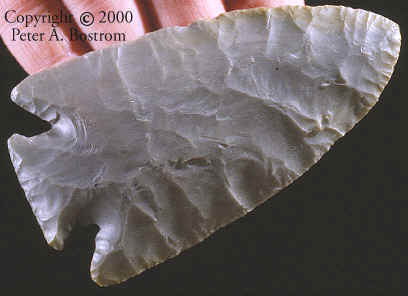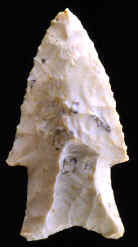|
HARDIN
BARBED
POINTS
CALHOUN CO., ILLINOIS
8,000-9,500 YEARS AGO
PRIVATE COLLECTION

CAST #A-3
HARDIN BARBED POINT
CALHOUN CO., ILLINOIS
8,000-9,500 YEARS AGO
PRIVATE COLLECTION
This Hardin Barbed point is an excellent example for the type. It was
found many years ago in Calhoun County, Illinois where examples were first
studied and named by Edward G. Scully. This example was actually found on
the Snyder's farm where the Hopewell culture Snyders point type site is
located.
This Hardin Barbed point is very well made by skillfully done
pressure flaking. It also has a distinctive "eared" base.
This point was made from a dark gray chert that may be either
Cobdin or Dongola cherts from southern Illinois. This Hardin Barbed point
measures 3 11/16 inches long.
Hardin Barbed points were named by Edward G. Scully for examples found in
Calhoun County, Illinois. The majority of these points are vary well made
with skillfully done pressure flaking. They are generally triangular in
outline with convex sides. Several different varieties of Hardin Barbed
points are known but they have yet to be named. Some even have long narrow
channel flakes removed from the base similar to some Dalton points. Others
have "Eared" bases, expanding to almost straight bases or concave
or convex bases. Most Hardin Barbed points were probably hafted onto short
handles made of wood or bone and used as knives. They were sharpened by
beveling the cutting edges.
Hardin Barbed points are believed to be an eastern relative of
Scottsbluff points from the Cody Complex in the western United States.
Hardin Barbed points are found in the eastern U.S. from Missouri to Ohio
& from Wisconsin to Arkansas. They date to the Early Archaic period
sometime between 8,000 and 9,500 years ago.
|
|
References:
Justice, Noel D., "Stone Age Spear and Arrow Points", pp 51-53.
Perino, Gregory, "Selected Preforms, Points and Knives of the North
American Indians Vol. 1", pp170-171.
|


